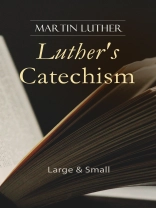‘Luther’s Large Catechism’ was addressed particularly to clergymen to aid them in teaching their congregations. It is divided into five parts: The Ten Commandments, The Apostles’ Creed, The Lord’s Prayer, Holy Baptism, and The Sacrament of the Eucharist. The Large Catechism typifies the emphasis which the churches of the Augsburg Confession placed on the importance of knowledge and understanding of the articles of the Christian faith. Primarily intended as instruction to teachers, especially to parents, the Catechism consists of a series of exhortations on the importance of each topic of the Catechism.
‘Luther’s Small Catechism’ is a catechism written for the training of children. It reviews the Ten Commandments, the Apostles’ Creed, the Lord’s Prayer, the Sacrament of Holy Baptism, the Office of the Keys and Confession and the Sacrament of the Eucharist. The Small Catechism is widely used today in Lutheran churches as part of youth education and Confirmation.
About the author
Martin Luther (1483-1546) was a German professor of theology, composer, priest, monk, and a seminal figure in the Protestant Reformation. Luther came to reject several teachings and practices of the Roman Catholic Church. He strongly disputed the Catholic view on indulgences and he proposed an academic discussion of the practice and efficacy of indulgences in his famous Ninety-five Theses of 1517. Luther’s refusal to renounce all of his writings at the demand of Pope Leo X and the Holy Roman Emperor Charles V resulted in his excommunication by the Pope and condemnation as an outlaw by the Emperor.












